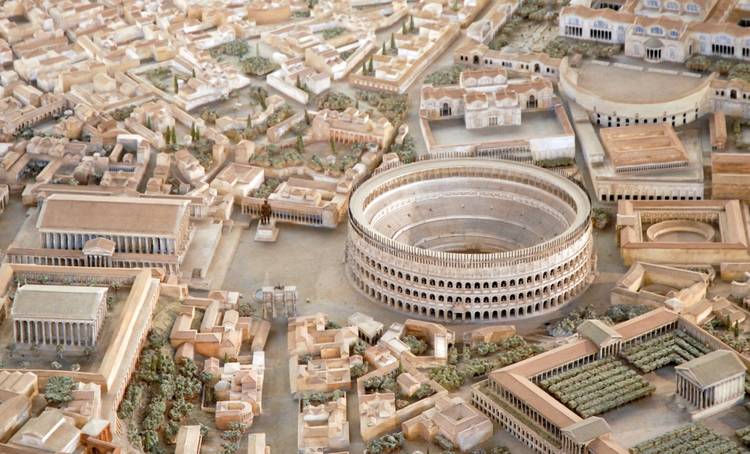


ROME -- Architect Pirro Ligorio, born in Naples, was just 22 years old in 1534 when he moved to Rome and fell in love with the city and especially its antiquities. After publishing a book on the circuses and amphitheaters of the ancient city, his work and studies on Roman antiquity culminated in his publishing in 1551 a giant map of reconstructed ancient Rome. Ligorio Antiquae Urbis Imago remained a hallmark study into the 1930s, when Italian archeologist Italo Gismondi began his 35-year project to reconstruct in plaster of Paris a model of Rome at the time of the Emperor Constantine (306 - 337). This 1/250 scale model, measuring 60 feet across, is in Rome's Museum of Roman Civilization.
That four centuries passed between these two famous reconstructions of ancient Rome from its ruins illustrates the challenge of the task. Now there is a new version: ancient Rome in 10-gigabyte virtual reality. Thanks to it, today's students, tourists and Rome lovers can (almost literally) soar all over reconstructed ancient Rome in a balloon 100 yards above the city for a bird's eye view, or what is today called "panoramic visualization." From the balloon a series of "apps" that can be run on home computers will allow the viewer to drop down into those building that are most intriguing. Among the first of 15 or 20 projected apps is one allowing a descent into the Basilica of Maxentius.
This newest version of ancient Rome was a long time coming. Forty years ago archaeologist Bernard Frischer, a summa cum laude graduate of Wesleyan University with a PhD from the University of Heidelberg, spent three years at the American Academy in Rome. From there he went on to teach Classics at UCLA and -- not incidentally -- Roman topography. In 2004, transferring to the University of Virginia, he founded the Virtual World Heritage Laboratory. Its goal: to utilize 3D digital tools that allow the simulation of cultural heritage sites, in order to encourage people to learn about them. Today classicist Frischer is also professor of informatics at Indiana University, where he continues to direct the Virtual World Heritage Laboratory.
This was the first such marriage of the very oldest and newest -- that is, the first attempt to use digital technology to recreate a vanished ancient city. It did not happen overnight. Speaking in Rome last week in a panel at the Foreign Press Association, Prof. Frischer, Director of Rome ReBorn, said that work on the project began 22 years ago. "We began with a scientific committee. Eventually it came to involve some 50 archaeologists, classicists and specialized technicians," he said.
As a result, from the ruins of the buildings and from meticulous scientific studies some 7,000 buildings that cover 14 sq. km. of city space can be seen in 3D. The period studied for reconstruction is, like that of Pirro Ligorio, from the year 320 AD, under Emperor Constantine at the peak of the city's development, with over 1 million inhabitants. "After Constantine left Rome, for centuries very few new buildings were added," explained Prof. Frischer.
Prof. Paolo Livorani is former curator of Vatican antiquities and a Rome ReBorn associate who teaches the urban topography of ancient Rome at the University of Florence. To the foreign press he explained that, "Since informatics change all the time, we must continually update our work. During the past year we have even been changing our views of the Roman Forum." The goal is not only to show the buildings, he added, but , from what is visible, to reconstruct the social life of that era. For instance, "From the street layout we can also gain an idea of the processions," he said.
Classicism in virtual reality, or VR, has positive results for young people. Monica De Simone is director of the Rieti Civic Museum. "The students are already accustomed to computer language. This lets them become familiar with objects from the deep past that they would otherwise first see on a shelf in a museum," she said. "In previews of the project, the students and the public were fascinated."
For internet blogger Anthony Vitello from Turin, "Schools in China are already using this. It's been shown that education via virtual reality is more alive than traditional education. You see Rome ReBorn in your school, and then you go to the Forum or into a museum, and you have an experience that is much more deeply involving. Studies show that students who have come to classicism in this way have greater retention of what they have seen."
Costs are kept low. Customers worldwide already include museums, public libraries, schools and universities, as well as private citizens. VR headsets greatly enhance visualization of the city and permit the fly-over viewer to move around, pausing over what interests him. To learn more, and to see a sampler of Rome ReBorn, see >> [2]
Source URL: http://test.casaitaliananyu.org/magazine/focus/art-culture/article/enjoy-birds-eye-view-ancient-rome
Links
[1] http://test.casaitaliananyu.org/files/italogismondijpg-0
[2] https://www.romereborn.org/content/flight-over-ancient-rome